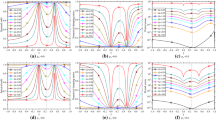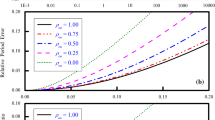Abstract
In this paper, a new family of controllably dissipative composite algorithms is developed to obtain reliable numerical response of structural dynamic problems. The proposed algorithm is a self-starting, unconditionally stable and second-order accurate three sub-step composite algorithm. The new method includes two optimal sub-families of algorithms, both of which can control numerical dissipations in the high-frequency range by an intuitive way, and their numerical dissipations can range from the non-dissipative case to the asymptotic annihilating case. Besides, they actually involve only one free parameter and always share the identical effective stiffness matrices inside three sub-step to save the computational cost, which does not hold in some existing sub-step algorithms. Some numerical examples are given to show the superiority of the new algorithm with respect to controllable numerical dissipations and the ability of capturing the free-play nonlinearity.





























































Similar content being viewed by others
References
Bathe, K.J.: Conserving energy and momentum in nonlinear dynamics: a simple implicit time integration scheme. Comput. Struct. 85(78), 437–445 (2007)
Bathe, K.J., Baig, M.M.I.: On a composite implicit time integration procedure for nonlinear dynamics. Comput. Struct. 83(31–32), 2513–2524 (2005)
Bathe, K.J., Noh, G.: Insight into an implicit time integration scheme for structural dynamics. Comput. Struct. 98–99, 1–6 (2012)
Bentez, J.M., Montns, F.J.: The value of numerical amplification matrices in time integration methods. Comput. Struct. 128(5), 243–250 (2013)
Chandra, Y., Zhou, Y., Stanciulescu, I., Eason, T., Spottswood, S.: A robust composite time integration scheme for snap-through problems. Comput. Mech. 55(5), 1041–1056 (2015)
Chang, S.Y.: Explicit pseudodynamic algorithm with unconditional stability. J. Eng. Mech. 128(9), 935–947 (2002)
Chang, S.Y.: A new family of explicit methods for linear structural dynamics. Comput. Struct. 88(1112), 755–772 (2010)
Chang, S.Y.: A family of noniterative integration methods with desired numerical dissipation. Int. J. Numer. Methods Eng. 100(1), 62–86 (2014)
Chang, S.Y.: Dissipative, noniterative integration algorithms with unconditional stability for mildly nonlinear structural dynamic problems. Nonlinear Dyn. 79(2), 1625–1649 (2015)
Chopra, A.K.: Dynamics of Structures: Theory and Applications to Earthquake Engineering. Prentice-Hall International Series in Civil Engineering and Engineering Mechanics, 4th edn. Prentice Hall, Upper Saddle River (2011)
Chung, J., Hulbert, G.M.: A time integration algorithm for structural dynamics with improved numerical dissipation: the generalized-\(\alpha \) method. J. Appl. Mech. 60(2), 371–375 (1993)
Dong, S.: BDF-like methods for nonlinear dynamic analysis. J. Comput. Phys. 229(8), 3019–3045 (2010)
Erlicher, S., Bonaventura, L., Bursi, O.S.: The analysis of the generalized-method for non-linear dynamic problems. Comput. Mech. 28(2), 83–104 (2002)
Gear, C.W.: Numerical Initial Value Problems in Ordinary Differential Equations. Prentice Hall, Upper Saddle River (1971)
Grosseholz, G., Soares Jr., D., Von Estorff, O.: A stabilized central difference scheme for dynamic analysis. Int. J. Numer. Methods Eng. 102(11), 1750–1760 (2015)
Hilber, H.M., Hughes, T.J.R.: Collocation, dissipation and overshoot for time integration schemes in structural dynamics. Earthq. Eng. Struct. Dyn. 6(1), 99–117 (1978)
Hilber, H.M., Hughes, T.J.R., Taylor, R.L.: Improved numerical dissipation for time integration algorithms in structural dynamics. Earthq. Eng. Struct. Dyn. 5(3), 283–292 (1977)
Hoff, C., Pahl, P.J.: Development of an implicit method with numerical dissipation for time integration algorithms in structural dynamics. Comput. Methods Appl. Mech. Eng. 67(3), 367–385 (1988)
Houbolt, J.C.: A recurrence matrix solution for the dynamic response of elastic aircraft. J. Aeronaut. Sci. 17(9), 540–550 (1950)
Hughes, T.J.R.: The Finite Element Method: Linear Static and Dynamic Finite Element Analysis. Dover Civil and Mechanical Engineering. Dover Publications, Mineola (2000)
Kim, W., Choi, S.Y.: An improved implicit time integration algorithm: the generalized composite time integration algorithm. Comput. Struct. 196, 341–354 (2018)
Kim, W., Reddy, J.N.: An improved time integration algorithm: a collocation time finite element approach. Int. J. Struct. Stab. Dyn. 17(2), 1750024 (2016)
Kim, W., Reddy, J.N.: A new family of higher-order time integration algorithms for the analysis of structural dynamics. J. Appl. Mech. ASME 84(7), 071008–17 (2017)
Klarmann, S., Wagner, W.: Enhanced studies on a composite time integration scheme in linear and non-linear dynamics. Comput. Mech. 55(3), 455–468 (2015)
Kolay, C., Ricles, J.M.: Assessment of explicit and semi-explicit classes of model-based algorithms for direct integration in structural dynamics. Int. J. Numer. Methods Eng. 107(1), 49–73 (2016)
Kuran, B., Özgüven, H.N.: A modal superposition method for non-linear structures. J. Sound Vib. 189(3), 315–339 (1996)
Li, J., Yu, K.: Noniterative integration algorithms with controllable numerical dissipations for structural dynamics. Int. J. Comput. Methods 15(3), 52 (2018)
Li, J., Yu, K.: An alternative to the Bathe algorithm. Appl. Math. Model. 69, 255–272 (2019)
Li, J., Yu, K., Li, X.: A generalized structure-dependent semi-explicit method for structural dynamics. J. Comput. Nonlinear Dyn. 13(11), 111008–20 (2018)
Newmark, N.M.: A method of computation for structural dynamics. J. Eng. Mech. Div. 85(3), 67–94 (1959)
Noh, G., Bathe, K.J.: Further insights into an implicit time integration scheme for structural dynamics. Comput. Struct. 202, 15–24 (2018)
Noh, G., Ham, S., Bathe, K.J.: Performance of an implicit time integration scheme in the analysis of wave propagations. Comput. Struct. 123, 93–105 (2013)
Rezaiee-Pajand, M., Karimi-Rad, M.: More accurate and stable time integration scheme. Eng. Comput. 31(4), 791–812 (2015)
Rezaiee-Pajand, M., Sarafrazi, S.R.: A mixed and multi-step higher-order implicit time integration family. Arch. Proc. Inst. Mech. Eng. Part C J. Mech. Eng. Sci. 1989–1996 (vols 203–210) 1(1), 1–12 (2010)
Soares, D., Großeholz, G.: Nonlinear structural dynamic analysis by a stabilized central difference method. Eng. Struct. 173, 383–392 (2018)
Wen, W.B., Wei, K., Lei, H.S., Duan, S.Y., Fang, D.N.: A novel sub-step composite implicit time integration scheme for structural dynamics. Comput. Struct. 182, 176–186 (2017)
Wilson, E.L.: A Computer Program for the Dynamic Stress Analysis of Underground Structure. SESM Report No. 68-1, Division of Structural Engineering and Structural Mechanics. University of California, Berkeley (1968)
Wood, W., Bossak, M., Zienkiewicz, O.: An alpha modification of Newmark’s method. Int. J. Numer. Methods Eng. 15(10), 1562–1566 (1980)
Yu, K.: A new family of generalized-\(\alpha \) time integration algorithms without overshoot for structural dynamics. Earthq. Eng. Struct. Dyn. 37(12), 1389–1409 (2008)
Zhang, H.M., Xing, Y.F.: Optimization of a class of composite method for structural dynamics. Comput. Struct. 202, 60–73 (2018)
Zhang, J., Liu, Y., Liu, D.: Accuracy of a composite implicit time integration scheme for structural dynamics. Int. J. Numer. Methods Eng. 109(3), 368–406 (2017)
Zhang, L., Liu, T., Li, Q.: A robust and efficient composite time integration algorithm for nonlinear structural dynamic analysis. Math. Probl. Eng. 2015, 11 (2015). https://doi.org/10.1155/2015/907023
Acknowledgements
This work is supported by the National Natural Science Foundation of China (Grant No. 11372084). This support is gratefully acknowledged. The helpful and constructive comments by the referees have led to the improvements of this paper; the authors gratefully acknowledge this assistance.
Author information
Authors and Affiliations
Corresponding author
Ethics declarations
Conflict of interest
The authors declare that there is no conflict of interests regarding the publication of this manuscript.
Additional information
Publisher's Note
Springer Nature remains neutral with regard to jurisdictional claims in published maps and institutional affiliations.
Appendix A
Appendix A
Derivation of the amplification matrix A for the three sub-step composite algorithm can be divided into the following steps:
First, applying the trapezoidal rule in the first sub-step to the SDOF system yields
where the amplification matrix \(A_{11}\) in the first sub-step can be written explicitly as
where \(\beta _1=\gamma _1^2\Omega ^2+4\gamma _1\xi \Omega +4\). \(\omega =\Omega /h\) and \(\xi \) are the undamped natural frequency and viscous damping ratio of the SDOF system, respectively.
Second, the similar calculation can be done in the second sub-step. And when \(\gamma _2=2\gamma _1\), the matrix–vector form can be given as
And the amplification matrix \(A_{22}\) is exactly identical to the amplification matrix \(A_{11}\) in the first sub-step, namely \(A_{22}=A_{11}\).
Then, the calculation in the third sub-step yields
where three iteration matrices \(A_{2s}\), \(A_{1s}\) and \(A_{0s}\) can be expressed as
where \(\beta _2=c_4^2\Omega ^2+2c_4\xi \Omega +1\). The coefficients \(c_1, c_2,c_3\) and \(c_4\) are determined by Eqs. (12).
In the end, substituting Eqs. (A1) and (A3) into Eq. (A4) yields
where the amplification matrix A of the new sub-step algorithm is given as follows
Hence, substituting Eqs. (A2), (A5)–(A7) into Eq. (A9) gives the explicit expression of amplification matrix A.
Rights and permissions
About this article
Cite this article
Li, J., Yu, K. & Li, X. A novel family of controllably dissipative composite integration algorithms for structural dynamic analysis. Nonlinear Dyn 96, 2475–2507 (2019). https://doi.org/10.1007/s11071-019-04936-4
Received:
Accepted:
Published:
Issue Date:
DOI: https://doi.org/10.1007/s11071-019-04936-4




